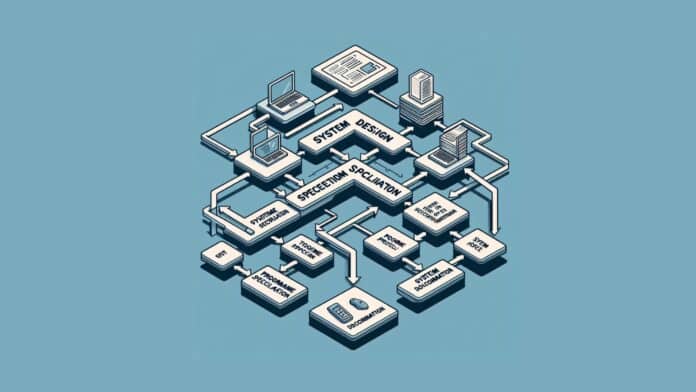System Design:
System design is a critical phase in software engineering that involves defining the architecture, interfaces, and data for a system to meet specific requirements. Let’s delve into the fundamental concepts of system design:

- What is System Design?: System design is the process of creating a blueprint for a software system. It encompasses decisions related to system architecture, module organization, data storage, and communication between components. The goal is to ensure that the system meets its intended purpose efficiently and effectively.
- Why Learn System Design?:
- Scalability: As web applications and services handle massive amounts of traffic and data, understanding system design is crucial. Apps like Facebook, Instagram, and Twitter serve billions of users concurrently, necessitating scalable systems.
- Career Growth: Whether you’re a beginner or an experienced developer, system design knowledge enhances your problem-solving abilities. It becomes even more critical during interviews for higher-level positions.
- Key Concepts and Topics:
- Horizontal and Vertical Scaling: Strategies for handling increased load by adding more servers (horizontal scaling) or upgrading existing servers (vertical scaling).
- Microservices: Designing systems as a collection of loosely coupled services.
- Proxy Servers: Managing requests and distributing load efficiently.
- CAP Theorem: Balancing consistency, availability, and partition tolerance in distributed systems.
- Redundancy and Replication: Ensuring fault tolerance and high availability.
- Storage Types:
- Block Storage: Used for raw data storage.
- File Storage: Organizing files in a hierarchical structure.
- Object Storage: Storing unstructured data like images and videos.
- RAID (Redundant Disk Arrays): Combining multiple disks for improved performance and reliability.
- Message Queues: Facilitating communication between components.
- Databases:
- Relational Databases (e.g., MySQL, PostgreSQL): Structured data storage.
- Non-relational Databases (e.g., MongoDB): Flexible schema and scalability.
- Database Sharding and Partitioning: Distributing data across multiple servers.
- Database Indexing: Optimizing query performance.
- Distributed Systems:
- MapReduce: Processing large datasets in parallel.
- Stateless and Stateful Systems: Understanding state management.
- Raft: Consensus algorithm for fault-tolerant systems.
- Scalable Web Applications:
- DNS and Load Balancing: Efficiently directing user requests.
- N-tier Applications: Layered architecture for scalability.
- HTTP and REST: Communication protocols.
- Stream Processing: Real-time data processing.
- Caching:
- Cache Invalidation: Keeping cached data up-to-date.
- Cache Eviction: Removing least-used data from the cache.
- Machine Learning and System Design: Integrating ML models into systems.
- Containerization and The Cloud: Leveraging containers and cloud services.
- Resources:
- For a comprehensive guide on system design interviews, explore the course: Grokking the Modern System Design Interview for Engineers & Managers.
- Additional tutorials are available on platforms like GeeksforGeeks and Crio.
SYSTEM SPECIFICATION

System specification is indeed a crucial step in the software development lifecycle.
What is system specification? It serves as a blueprint for building a system that aligns with user expectations and business goals. Let’s break down the key components:
- Functional Requirements: These describe what the system should do. They outline specific features, interactions, and behaviors. For example, “The system must allow users to log in using their email and password.”
- Non-Functional Requirements: These address qualities like performance, security, usability, and scalability. Examples include response time, data encryption, and accessibility compliance.
- Use Cases: Use cases depict interactions between actors (users, systems, or external entities) and the system. They help identify scenarios and validate system behavior. For instance, “User places an order online.”
- User Stories: These are concise descriptions of system functionality from a user’s perspective. They follow the format: “As a [user role], I want [action] so that [benefit].” For example, “As a customer, I want to view my order history.”
- Acceptance Criteria: These define conditions that must be met for a feature or user story to be considered complete. They help ensure alignment with stakeholder expectations. For instance, “The search functionality should return results within 2 seconds.”
3. LIST TOOLS FOR SYSTEM SPECIFICATION:
- Unified Modeling Language (UML): A standardized visual modeling language for specifying, visualizing, constructing, and documenting the artifacts of software systems.
- Requirements Management Tools: Software tools used to capture, analyze, prioritize, and track system requirements throughout the development lifecycle.
- Prototyping Tools: Tools that enable the creation of interactive prototypes to demonstrate system functionality and gather feedback from stakeholders.
- Document Templates: Standardized templates and formats for documenting system requirements, use cases, and specifications.
- Collaboration Platforms: Online platforms for collaborative requirement gathering, discussion, and documentation among project teams and stakeholders.
- PROGRAMMING SPECIFICATION:
Program specification involves detailing the functionalities, inputs, outputs, processing logic, and interfaces of individual programs within a system. It defines the behavior of each program and its interactions with other components to achieve desired system functionality.
5. TOOLS OF PROGRAMMING:
- Integrated Development Environments (IDEs): Software applications that provide comprehensive facilities for software development, including code editing, debugging, compilation, and deployment.
- Version Control Systems (VCS): Tools that enable tracking changes to source code files, facilitating collaboration among developers and ensuring version management.
- Programming Languages: Various programming languages such as Python, Java, C++, and JavaScript, each with its syntax, semantics, and libraries.
- Debugging Tools: Software utilities for identifying and resolving errors, bugs, and issues in code during development.
- Code Editors: Lightweight tools for writing and editing source code, offering syntax highlighting, auto-completion, and code navigation features.
6. SYSTEM DOCUMENTATION:
System documentation involves creating comprehensive records and descriptions of a system’s architecture, components, functionalities, interfaces, and operations. It includes:
Input Documentation: Description of input data sources, formats, and requirements.
Output Documentation: Specification of output formats, destinations, and delivery mechanisms.
Processing Documentation: Explanation of algorithms, procedures, and workflows involved in processing data and executing system functions.
Access Control Documentation: Definition of user roles, permissions, authentication mechanisms, and data security measures.
Standards Compliance: Ensuring adherence to industry standards, best practices, and regulatory requirements in system design, development, and documentation.
These components collectively provide a comprehensive reference for system stakeholders, developers, and users, facilitating understanding, maintenance, and evolution of the system.




















